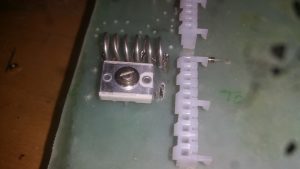After successfully testing the power supply on my TVT’s mainboard, I now need to move on to actually making the TVT do something. The next instructions from the guide have me building the RF modulator, which is the component that gives the TV Typewriter its name. As mentioned before, I have had advice not to bother with this and just go with straight composite video. However, I felt doing this, while easier, would sidestep the main achievement of the device, which was that it used something everyone had in their home (a TV) already.
Anyway, building the RF modulator is straightforward enough – the trickiest bit is winding the 14ga tinned bus wire into a coil that helps generate a signal for the TV to pick up. You can see the result behind the trimmer capacitor. The wire is very thick and does not want to twist into a coil easily. It requires the use of a 3/8″ drill bit and very strong hands. There is a point on the second coil from the right where a tiny piece of wire ‘taps’ (is soldered) into it to draw the signal.
After that, I install all the required pieces, including my 300ohm twinlead with ‘gimmick attenuator’. If you’re of a certain age, you’ll remember that twinlead is basically a flat cable with two wires embedded in either side. In the days before TVs had coax inputs, you had screw terminals on the back for VHF and UHF reception. These twinlead cables went between there and the antenna attached to your house. The ‘gimmick’ attenuator is nothing more than a short piece of twinlead that is cut and electrical taped a few inches up from where the twinlead is soldered into the mainframe board. This provides a kind of capacitor that further hones the signal going to the TV, so as not to overpower it.
With everything installed, we are ready to do a test! The goal of this part of construction is to find a channel between 2 and 5 we can tune the device to. At this stage, we are trying to tune it so that the screen goes completely blank, and any static noise is minimized or eliminated. Ultimately I found the best channel to tune to was 5. Here is a video of my dialing it in (please ignore my messy shop!):
https://www.youtube.com/watch?v=fAgutx0Bro8
You can see how the screen goes to a solid blue. Offscreen, I am using a small screwdriver to achieve that screen by adjusting the 33pf trimmer capacitor next to the coil. Anyway, there you have it! Another exciting first step towards a working TVT!

